Viola sheltonii
Description. Illustrations: 6 photographs of Viola sheltonii and 2 drawings.
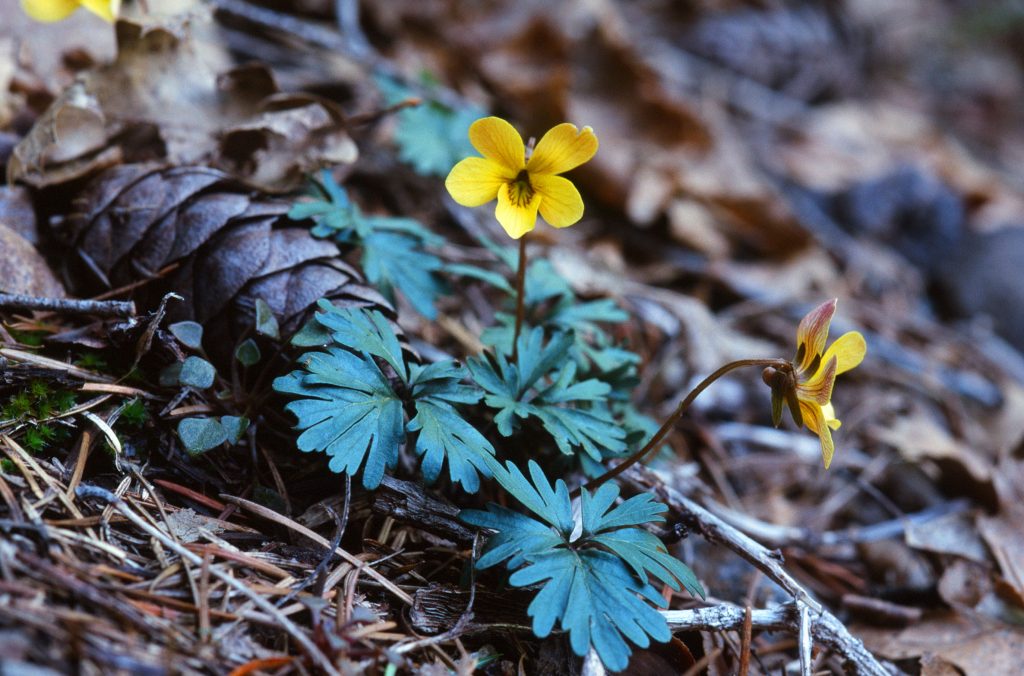
Two separate montane populations of V. sheltonii exist: one west from the Sierra Nevada Mountains of California, Oregon and Washington states, the other in the Rocky Mountains, from Montana to southwestern Colorado. Half of the plant remains underground, so that the crown of the plant is safe from extremes of temperature, fire, and grazing animals. The deeply dissected foliage spreads out horizontally in a flat plane, those in more shade appear glaucous while in sunnier locations they can be dark green. Flowers appear so early in spring that there may still be some snow on the ground in nearby shaded areas. Their color varies from deep lemon to bright yellow on the face with purple veining on the reverse, usually only on the two upper petals. The plants die down in summer somewhat later than other members of the Chrysanthae, allowing time for the development and maturation of cleistogamous seed pods.
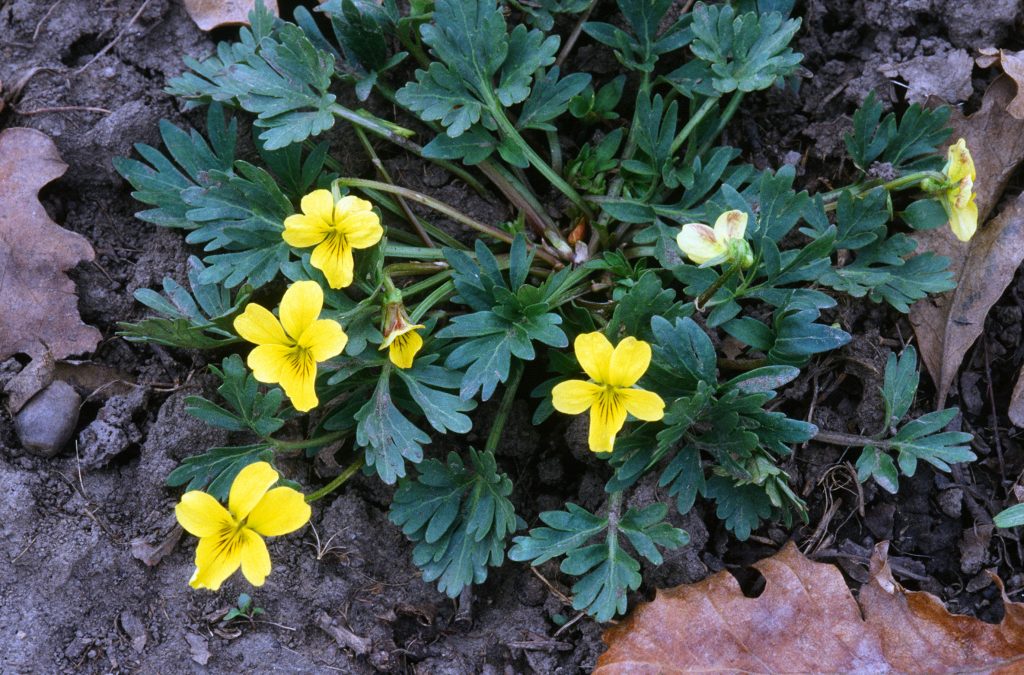
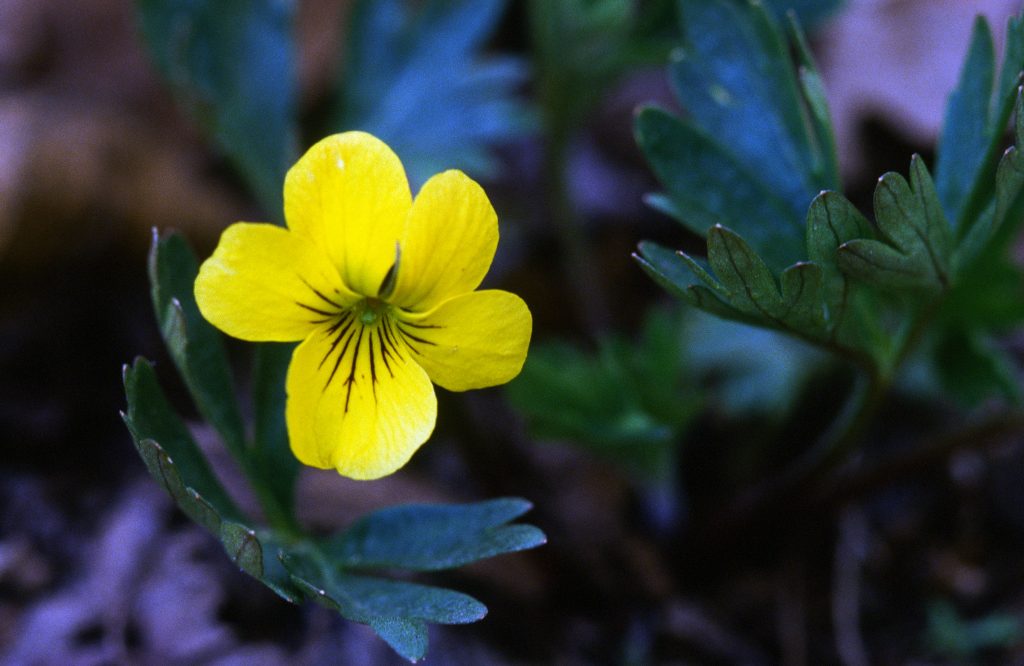
What appear to be several plants in a large area may actually be only one individual whose underground white petioles, stems and peduncles are widely spread from an erect rhizome. Plants are 3–27 cm high. Basal petioles are very long, equalling the height of the cauline petioles. The above ground portion of the plants is glabrous to pubescent, purple, to 15 cm high.

Leaves are cordate to reniform in outline, wider and larger than those of beckwithii or douglasii, the basal leaf 5-7 cm long x 3-5.5 cm wide and cauline leaves a little smaller.
Leaves all finely divided, the lamina initially deeply divided ternately or palmately into cuneate lobes, each of which is divided again ternately, and each of these a third time. The resulting segments are linear to obovate. There is a small gland at the tip of each leaf division. The upper leaf surface is dark green, the lamina and veins with short bristly appressed hairs; the lower leaf surface paler green-purple, glabrous or with scattered very short fine hairs. Leaf margins are decurrent on the petiole, incurved and ciliate. Basal stipules are adnate for all but the top 2-3 mm. Cauline stipules glabrous, adnate to the base of the petiole, 2mm long, with short glandular-tipped fimbriae on outside margin, pale green-purple to almost colourless.
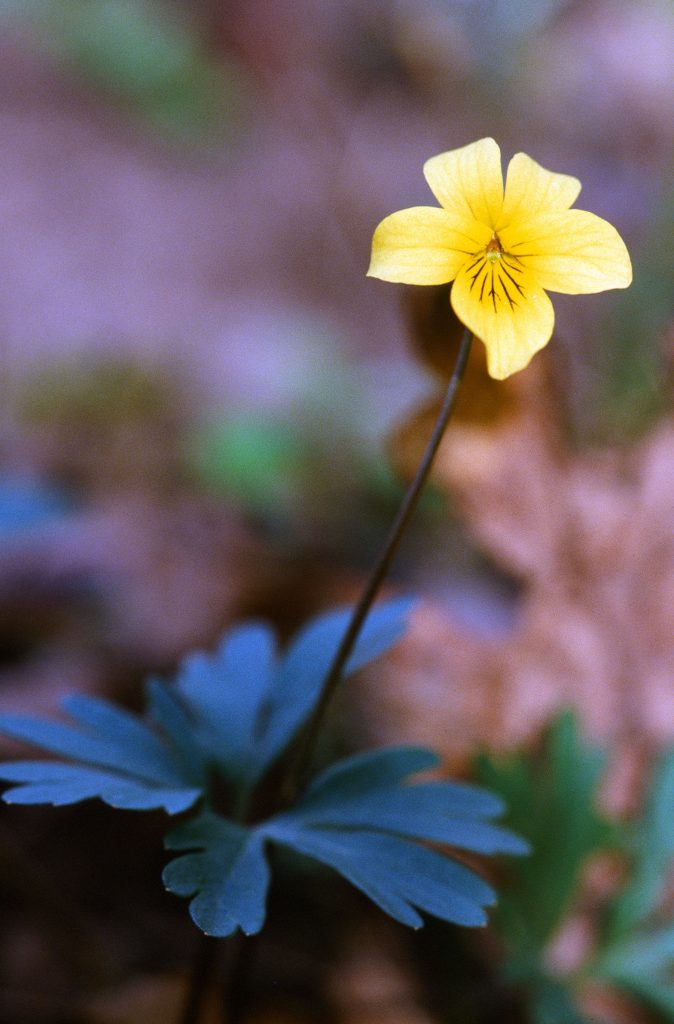
Flowers held above leaves on axillary peduncles, purple at base with pubescence of very short hairs; bracteoles about the middle of the peduncle, pale green to scarious, 3-6 mm long, glabrous. The western form is shy to flower, especially if it is growing in shaded areas. Pale to dark purple axillary peduncles, with bracteoles above the middle, carry the large yellow flowers above the leaves. Flowers are 2.2-3 long x 2.2-2.5 cm wide; the petals are veined rusty brown on the outside surface usually only on the two upper petals; the lateral petals are sparsely bearded with clavate hairs, the lower three petals with short dark guidelines though not as dark or heavy as V. douglasii; the lowest spurred petal nearly twice the width of the others. The petal spur is pale yellow-green, flattened in section, and rounded at the end, 1-1.5 mm long x 2-2.5 mm wide. The ovary is spotted purple, glabrous or shortly pubescent, the style head with a few short hairs on the sides, stigmatic opening with a short upturned beak. The calyx is green to purple, glabrous to short ciliate; sepals oblong ending abruptly, appendages thick, rounded. Sepals on the cleistogenes are recurved.
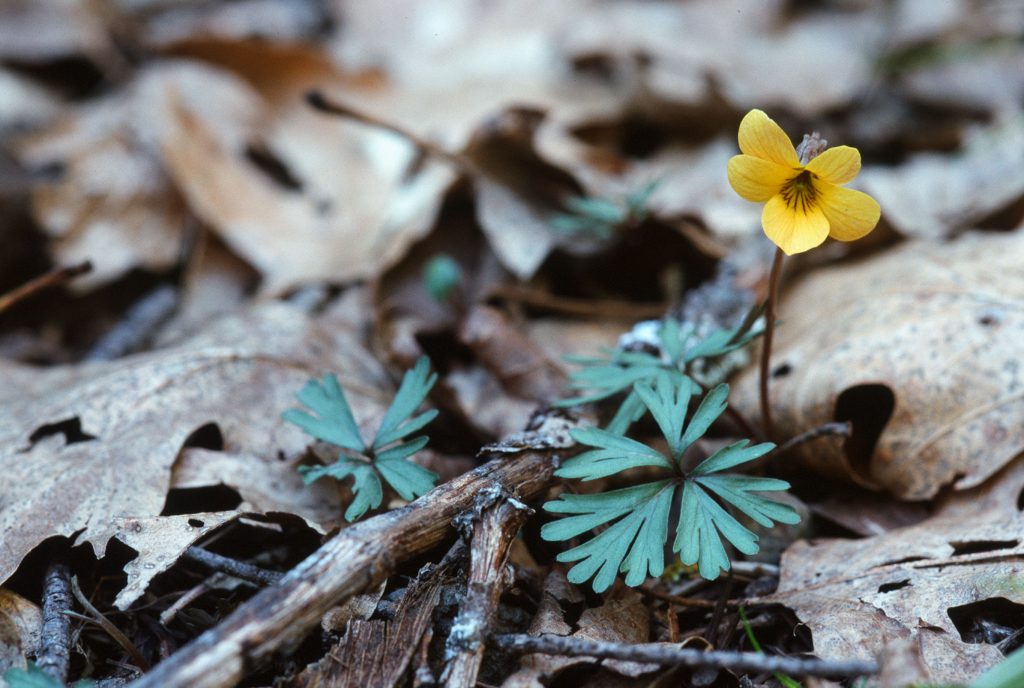
Capsules are large, round-ovoid, glabrous to densely ciliate, green, heavily spotted purple or all purple, 6–8 mm long. Cleistogamous seed pods rise from below soil level on long erect peduncles becoming prostrate with age. Seeds cream, 2.3-3.5 x 1.3-2.0 mm.
The western population of Viola sheltonii grows in partial shade in openings of lightly wooded mixed conifer and oak forests, in a humus-rich loam, sandstone, slate, mudstone, weathered granite or basalt. There is abundant spring moisture, often from melting snow. It can occur near Viola lobata but flowers 3-4 weeks earlier. The leaves can be easily confused with those of developing delphiniums, but those of the violet have more terminal divisions. The Rocky Mountain plants are growing in rich, heavy, black soil, full sun or partial shade beneath oak brush. In the two sites where I have observed this form of Viola sheltonii, the fertile soils are derived from dark Mancos Shale. A high clay content causes this to swell when wet, a condition to which many plants cannot adapt. During the Cretaceous Period most of Colorado was submerged below the sea, the sandy shore deposits that would become the Dakota Sandstone were blanketed by a layer of marine animal skeletons, which formed the Mancos Shale.
Distribution of this species is from the northern side of the Columbia River in Southern Washington State, to California: Klamath Ranges, north High Sierra Nevada Range, Warner Mountains, San Francisco Bay Area, South Coast Ranges, north Western Transverse Ranges, San Bernardino Mountains and northwest Peninsular Ranges. It is also common on the west slopes and plateaus of the Rocky Mountains from Montana to southwestern Colorado. Usually growing at higher elevations: 800–2750 m.

Nomenclature and Taxonomy:
Sect. Chamaemelanium subsect. Chrysanthae (Clausen, 1964).
Viola sheltonii Torrey
John Torrey, 1796-1873
(Syn. Viola sheltonii var. biternata A.Nelson Bot. Gaz. 56: 66. 1913;
Viola biternata Greene Pl. Baker. 3: 12. 1901).
The only diploid species in subsection Chrysanthae. 2n=2x=12, where x=6, the base chromosome number for the subsection.
It was named in honor of the Reverend Mr. Shelton, who botanized about 1857 in Plumas, Sierra and Nevada counties of California. In 1901 the disjunct Colorado populations were described by Greene as V. biternata. These plants are larger, softer, greener and more divided, though there do not seem to be any other quantifiable differences. The lushness and golden flower color of these plants may be due to soil richness. Greene’s description states that it is ‘related to V. sheltonii of the Far Northwest but very different.’ Nelson made it a variety of V. sheltonii in 1913, and it has not been discussed in print since then.
This species does not fit neatly into Clausen’s classification of subsection Chrysanthae because it does not share some the important characteristics typical of other species: a persistent fibrous sheath of petioles and their attached stipules enclosing the stems, dark markings on the lateral petals and a lack of cleistogenes. The underground stems are ‘naked’, white, spreading and sometimes mistaken for stolons. Leaves are divided in a different pattern, the secondary and tertiary divisions not as deeply cut towards the midvein, but often terminally divided a fourth time. The habitats are not as suddenly dry in summer. However, it does share the habit of a deeply buried rhizome and summer dormancy.
On p. 176 of Doretta Klaber’s book ‘Violets’ the labels on the plates CVII and CVIII illustrating V. sheltonii and V. douglasii are reversed.